Mad Hedge Biotech and Healthcare Letter
March 1, 2022
Fiat Lux
Featured Trade:
(THE FUTURE OF SURGERY)
(ISRG), (MDT), (SYK), (ZBH), (JNJ)
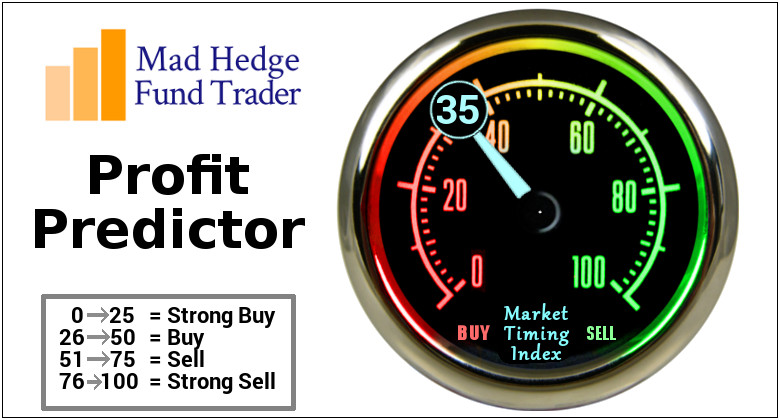
Mad Hedge Biotech and Healthcare Letter
March 1, 2022
Fiat Lux
Featured Trade:
(THE FUTURE OF SURGERY)
(ISRG), (MDT), (SYK), (ZBH), (JNJ)

The healthcare sector is one of the biggest and most intricate industries in the stock market.
It’s a multi-trillion dollar area that offers investors with virtually unlimited opportunities to build a life of financial freedom via sound long-term investing.
This industry has several quality stocks—businesses that offer to cure diseases, develop revolutionary medical devices and treatments, or even just to offer personal care items you purchase from drugstores.
One of the most lucrative sectors of the field is surgery.
Surgery dates back centuries and is one of the oldest practices in the field of healthcare and medicine. Thankfully, its technology has evolved since then.
The surgical robotics market is projected to expand exponentially, and ISRG is in a prime spot to reap the rewards from this impending growth.
So far, approximately 15% of surgeries are already conducted via robots, showing a massive room for expansion as the technology gains traction among the medical experts and patients.
Robotic assistants are gradually entering the mainstream market, opening another revenue stream. Overall, the anticipated market for this field is calculated to rise at a range somewhere from 9.5% to 19.3% from 2022 to 2032.
The growth won’t likely stop there considering the myriad of benefits that robotically assisted surgeries offer compared to traditional surgeries, such as shorter recovery periods and alleviated discomfort among patients.
These advantages make these systems attractive to healthcare providers, especially considering the way the technology optimizes the recovery process of their patients and delivers more precise and safe surgical results.
Today, one of the emerging leaders in this sector of the healthcare community is Intuitive Surgical (ISRG).
Basically, ISRG is a company that focuses on medical devices, specifically on minimally invasive robotic systems that perform surgeries. Its flagship platform is called the “Da Vinci” system.
To date, it has installed roughly 6,700, with revenue climbing by 12% annually over the past decade.
Since the launch of the da Vinci platform, ISRG has expanded at quite a rapid pace. Its revenue climbed from $1.8 billion in 2011 to $5.7 billion in 2021.
In terms of expanding its services, ISRG recently announced a new platform called Ion. This is a lung biopsy robot, which is projected to become yet another remarkable revenue stream for the company.
The more da Vinci units ISRG ships out, the stronger its competitive edge becomes.
Aside from raking in profits from their surgical robotic units, which typically cost roughly $500,000 to $2.5 million depending on the complexity of the machine, the da Vinci units require a considerable time investment to master its operation.
This leads to high switching expenses, which all but guarantees retained and returning clients for ISRG’s business.
To put this into context, system revenue for ISRG was recorded at $1.7 billion in 2021. This indicates that about 70% of its $5.7 billion total revenue came from recurring products and services.
Thus far, ISRG has been the dominant leader in this cutting-edge space in healthcare and has shown incredible growth since its IPO. More importantly, the company has an impressive cash flow and cash balance.
Moreover, ISRG is an industry leader. As with every company in this position, ISRG has captured the lion’s share of the market.
At this point, the company currently controls 80% of the market and is expected to increase this dominance as it continues to make headway.
Considering the massive potential of this market, it comes as no surprise that more and more companies are working to topple ISRG.
Other companies have already started introducing their own specialized robots.
Medtronic (MDT) launched a spine and brain robot, Stryker (SYK) created one for knee and hip replacement, and Zimmer Biomet (ZBH) introduced a competitor in the spine and knee procedures space. Even Johnson & Johnson (JNJ) entered the fray with its lung biopsy robot.
Overall, ISRG is a brilliant company.
It possesses technological superiority over its rivals and a virtual monopoly of a rapidly growing market. These factors make ISRG an excellent long-term healthcare stock to buy and forget.
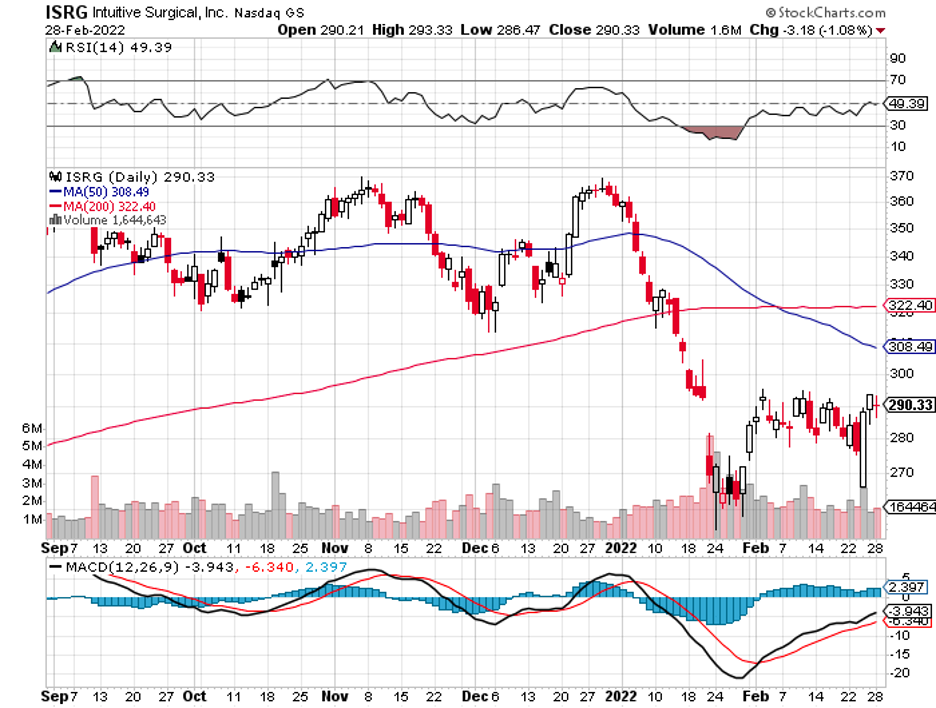
Mad Hedge Biotech and Healthcare Letter
November 18, 2021
Fiat Lux
Featured Trade:
(A GROSSLY OVERLOOKED REOPENING PLAYER)
(ISRG), (JNJ), (SYK), (BDT), (MDT)
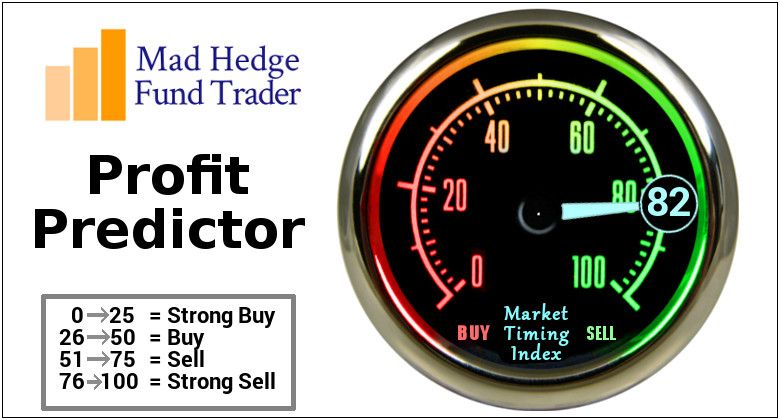
Some people say that the entirety of November can be considered the Halloween season for investors, especially with the current stock market climate.
Stock valuations are higher than ever, while inflation has started to rear its ugly head since the month began.
Personally, I don’t believe that investors should be scared.
Throughout history, there has always been a bogeyman or two emerging as a reason to veer far away from the stock market. More often than not, though, these frightening situations tend to be overblown.
One of the companies that investors are afraid to risk their money on is Intuitive Surgical (ISRG).
However, Intuitive Surgical has the markings to realistically expand to 10X or even more over the following decades.
If anything, I think this is a stock that investors should be more frightened to pass up rather than to buy.
Admittedly, Intuitive Surgical’s high-tech robotic surgical platforms do look sort of scary. Nonetheless, the stock tells a completely different story.
Intuitive Surgical is a pioneer in robotic surgery, with the company’s work dating back to the late 1990s.
To date, it has over 6,500 of its systems installed across the globe and more than 9.7 million procedures performed utilizing its robotic platforms.
Basically, Intuitive Surgical offers a robotic-assisted surgery structure called the “da Vinci System.”
Surgeons use this in an effort to lessen the invasiveness of surgeries. The company’s robotic systems have been used in various surgery types like gallbladder, hernia, gynecological, colorectal, and bariatric.
While the da Vinci System has become synonymous with Intuitive Surgical, what most people don’t know is that the company gets the majority of its revenue from recurring orders of accessories, instruments, and service.
In fact, these comprise 69% of the company’s revenue in the first 6 months of 2020, with the number rising to 72% during the same period in 2021.
After all, hospitals invest millions in buying the machines and training the surgeons, so it makes sense that they want to keep them in tiptop shape.
Although these numbers look impressive, the truth is that Intuitive Surgical is barely scratching the surface of this opportunity.
Given its history and growth trajectory, the company projects that it will perform approximately 6 million procedures annually based only on its systems with regulatory clearances. In comparison, Intuitive Surgical recorded 1.2 million procedures in 2020.
Intuitive Surgical still believes that it can surpass this projected five times growth opportunity despite this promising outlook.
In recent years, the company has been investing heavily in its R&D sector to expand its reach.
One of the potential markets in its sights is the soft-tissue surgery segment, which has recorded roughly 20 million procedures every year.
And these are all based on the current population. If we factor in the aging demographics, then we can definitely expect to drive the volume higher in the coming decades.
Considering the massive potential of this market, it comes as no surprise that Intuitive Surgical faces more and more competition.
Although several big and small companies have tried to enter the robotic surgical systems segment, none can compare to the proven track record of Intuitive Surgical.
Given the 20-year headstart of Intuitive Surgical, saying that it would be difficult to catch up to its accomplishments is an understatement.
Moreover, the company controls roughly 80% of the surgical robotics market globally—and that’s a multi-billion dollar market.
Some of the companies trying to penetrate the space are Johnson & Johnson (JNJ) , Stryker Corporation (SYK), Becton, Dickinson, and Company (BDX) and Medtronic (MDT).
Intuitive Surgical has a proven track record of being one of the most notable regardless of industry, even in terms of profitability.
If you compare its bottom line, net profit margin, to its competitors, the company’s margin looks so much better than the combined margin of SYK, BDX, and MDT.
Bear in mind that the medical technology sector is one of the areas that will tremendously benefit from the reopening.
While it’s not top of mind, many elective surgeries and diagnoses were sidelined during the lockdowns.
The influx of COVID-19 cases in hospitals caused many doctors to delay these procedures, and patients didn’t want to risk infection either. This resulted in a colossal backlog of elective surgeries.
With the vaccination rates going up and the pandemic getting handled more efficiently, these very same patients will need to get treatment for the postponed surgeries.
Needless to say, this will trigger a post-pandemic boom in the elective surgeries and diagnostics field—and Intuitive Surgical will be there, ready and waiting to reap the rewards.
Overall, Intuitive Surgical is a safe pick with impressive growth potential.
Other than the immediate benefits from the post-COVID-19 era, the company has a remarkable expansion rate and innovative technology.
It’s good to be reminded though, that best-in-breed stocks don’t go on sale as frequently. The truth is, Intuitive Surgical isn’t for bargain hunters.
However, it’s a successful company that’s worth adding, especially on the dip and holding for long-term investors.
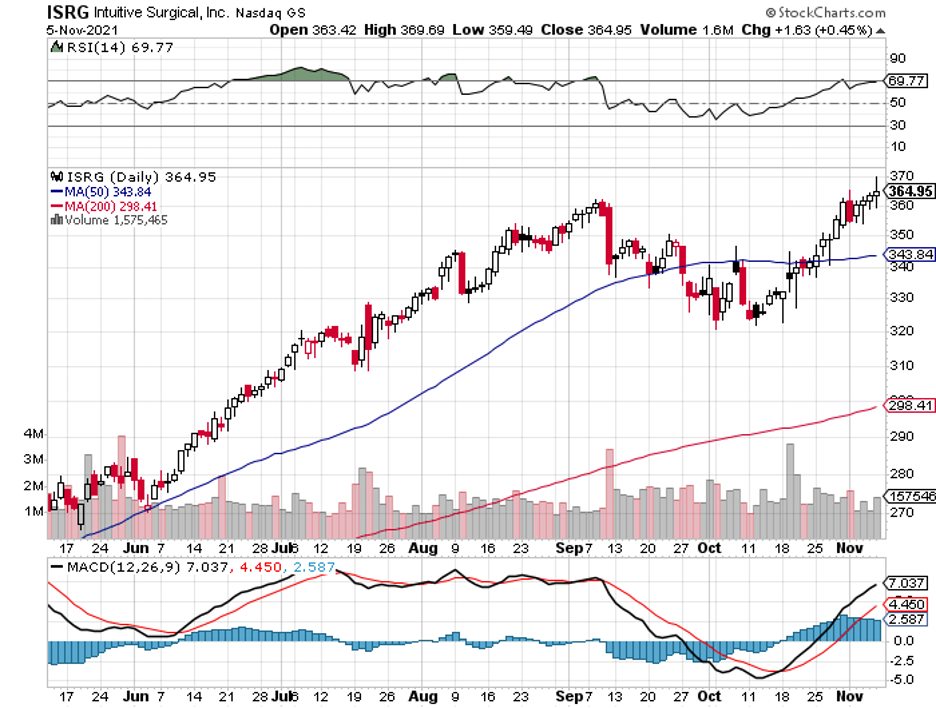
Mad Hedge Biotech & Healthcare Letter
April 29, 2021
Fiat Lux
FEATURED TRADE:
(A CANCER PLAY OFF THE BEATEN PATH)
(NVCR), (MRK), (ISRG)
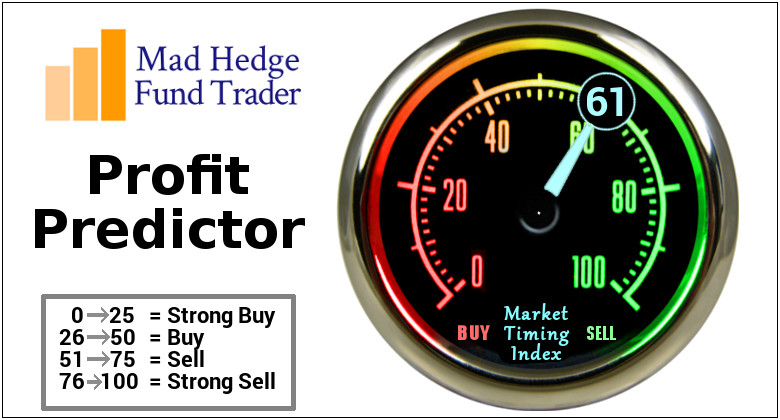
How can you surprise the world? More often than not, a revolutionary solution comes from an unconventional idea that initially gets mocked for its ridiculousness.
Over time though, this very same idea gains traction and the masses gradually see its value.
In the biotechnology world, this came in the form of a physicist searching for a novel approach to battle cancer.
This is how Novocure (NVCR) came to life.
When we look at cancer and how it’s treated, we think about the traditional pharmaceutical companies and their treatments, including radiation, drugs, and surgery.
Novocure has been forging its own unique track in the field of oncology.
The company’s technique is groundbreaking, presenting a different approach from the various forms of chemotherapy proposed.
It’s not even close to the trend of coming with new lines of drugs like Merck (MRK) with Keytruda.
Novocure uses a device, which it calls Optune.
This is worn over a cancer patient’s head. The device then generates an electric field that can help beat cancer. Sounds like a science fiction idea, doesn’t it?
While some call it absurd, Novocure’s idea is actually remarkable.
In layman’s terms, the premise is that cells are held together through an electric charge.
The goal is to blast solid cell tumor cancers using a specific currency to disrupt the charge, thereby inhibiting the tumor’s capability to stay together.
Basically, Novocure uses electro-fields to break up the cell division process that leads to the growth and spread of cancer.
By not letting the tumor replicate, Novocure’s device is dramatically boosting the patient’s capacity to battle the disease.
This therapy is called “Tumor Treating Fields” (TTFields).
While TTFields are definitely promising, these cannot replace traditional therapies. Rather, these are expected to be used alongside or in combination with other treatments, particularly chemotherapies and other direct targeted medications.
Founded in 2000, Novocure received its first FDA approval in 2011.
At the time, the New Jersey-based company developed TTFields for glioblastoma, which is an extremely aggressive type of cancer that originates in the brain and has a very low survival rate.
Since then, the company has been working to expand its regulatory footprint.
Recently, Novocure received FDA approvals for the expanded use of TTFields to cover more cases of glioblastoma.
It also has the green light for mesothelioma, which is typically caused by asbestos and affects the lining of the lungs and chest wall.
Novocure also has late-stage trials for therapies geared towards non-small cell lung cancer, pancreatic cancer, brain metastasis, and ovarian cancer.
Aside from inhibiting tumor cells from replicating, TTFields can also stop DNA damage, induce cell regeneration or autophagy, decrease cell migration, and trigger immune responses.
In terms of collaborators, Novocure has attracted the attention of Merck. While not much is known about their partnership, the two companies have been linked in some projects, including abdominal cancer therapies.
Reviewing the company’s pipeline and track record, it’s reasonable to say that Novocure is a growth stock.
However, its fundamentals are much stronger compared to other companies that are in the early stages.
Novocure’s revenues have steadily increased annually, driven by a series of growth levers.
One of them is its increased market share, with more and more patients using the therapy.
Another is the growing number of use cases for TTFields, with the company expanding to apply the treatment to other cancers. Lastly, there are new geographies to be tapped.
Since 2016, the company’s revenues have grown from only $82.9 million annually to an impressive $494 million in 2020.
In fact, 2020 was a good year for Novocure, showing off a 41% revenue growth since 2019. For 2021, the company is estimated to record at least a 21% increase in its profits.
Two factors could play key roles in achieving this goal.
The first is that the company has finally reached the point of profitability. While its R&D expenses rose due to the new case approvals, Novocure still managed to rake in a positive net income last year. Plus, the company has been rapidly boosting its operating cash flow.
The second is that Novocure has been conscientious in ensuring that its balance sheet remains fairly clean.
In an effort to raise funds, the company has decided to issue equity. While it does have roughly $430 million in gross debt, Novocure investors should see more cash flow thanks to the accelerated stamp of approval the company received for its TTFields therapy.
While growth investors are used to seeing this kind of movement, the objective is to turn the corner and earn a profit eventually.
Hence, it’s promising to see Novocure moving in that direction earlier than anticipated.
At this point, Novocure is the only company offering this treatment. This means it has no direct competitor in the market.
Needless to say, every use case of TTFields that earns approval amplifies Novocure’s total addressable market.
In terms of growth trajectory, the most similar company I can compare Novocure to is Intuitive Surgical (ISRG).
In 2010, ISG’s share price was in the $90 range. By 2021, the company has been trading at roughly $750 per share.
Based on its performance so far, Novocure flashes a similar potential just in a different vertical. In fact, Novocure is estimated to trade at roughly $600 per share or higher by 2025.
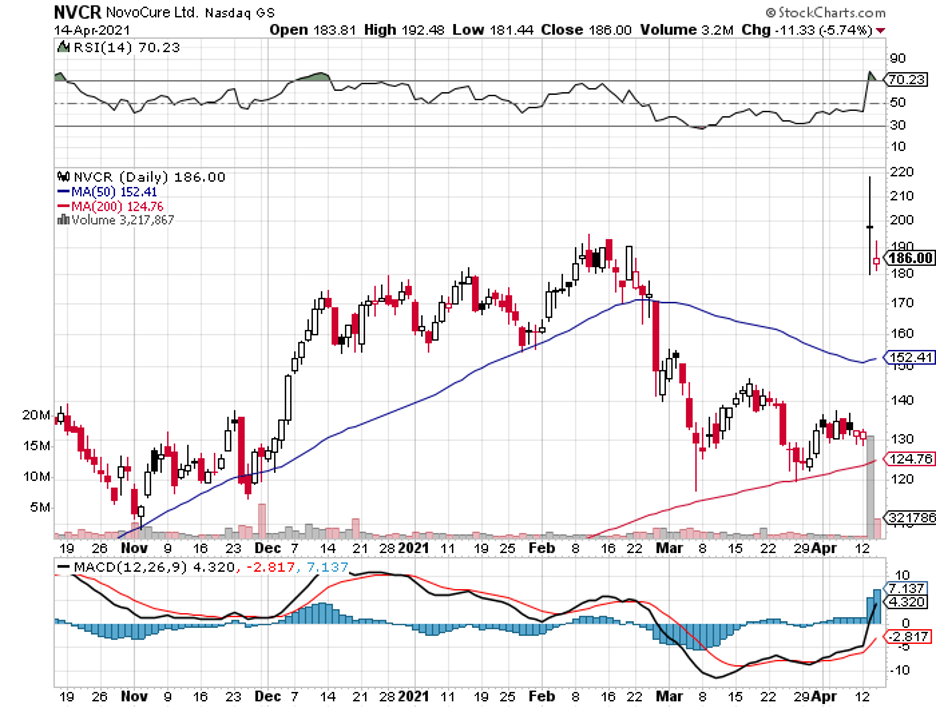
Global Market Comments
March 31, 2021
Fiat Lux
Featured Trade:
(HERE’S AN EASY WAY TO PLAY ARTIFICIAL INTELLIGENCE),
(BOTZ), (NVDA), (ISRG)

We are now seven months into the tech correction, and it may come to an end in a month or two. That turn will be dictated by the topping in the ten-year US Treasury bond somewhere around the 10% yield.
So, generational opportunities are starting to open up in some of the best long-term market sectors. It’s time to start building your list of names for when the sun, moon, and stars line up.
Suppose there was an exchange-traded fund that focused on the single most important technology trend in the world today.
You might think that I was smoking California’s largest export (it’s not grapes). But such a fund DOES exist.
The Global X Robotics & Artificial Intelligence ETF (BOTZ) drops a golden opportunity into investors’ laps as a way to capture part of the growing movement behind automation.
The fund currently has an impressive $2.6 billion in assets under management.
The universal trend of preferring automation over human labor is spreading with each passing day. Suffice to say there is the unfortunate emotional element of sacking a human and the negative knock-on effect to the local community like in Detroit, Michigan.
But simply put, robots do a better job, don’t complain, don’t fall ill, don’t join unions, or don’t ask for pay rises. It’s all very much a capitalist’s dream come true.
Instead of dallying around in single stock symbols, now is the time to seize the moment and take advantage of the single seminal trend of our lifetime.
No, it’s not online dating, gambling, or bitcoin, it’s Artificial Intelligence.
Selecting individual stocks that are purely exposed to A.I. is challenging endeavor. Companies need a way to generate returns to shareholders first and foremost, hence, most pure A.I. plays do not exist right now.
However, the Mad Hedge Fund Trader has found the most unadulterated A.I. play out there. A real diamond in the rough.
The best way to expose yourself to this A.I. trend is through Global X Robotics & Artificial Intelligence ETF (BOTZ).
This ETF tracks the price and yield performance of ten crucial companies that sit on the forefront of the A.I. and robotic development curve. It invests at least 80% of its total assets in the securities of the underlying index. The expense ratio is only 0.68%.
Another caveat is that the underlying companies are only derived from developed countries. Out of the 10 disclosed largest holdings, seven are from Japan, two are from Silicon Valley, and one, ABB Group, is a Swedish-Swiss multinational headquartered in Zurich, Switzerland.
Robotics and A.I. walk hand in hand, and robotics are entirely dependent on the germination prospects of A.I. Without A.I., robots are just a clunk of heavy metal.
Robots require a high level of A.I. to meld seamlessly into our workforce. The stronger the A.I. functions, the stronger the robot’s ability, filtering down to the bottom line.
A.I. embedded robots are especially prevalent in military, car manufacturing, and heavy machinery. The industrial robot industry projects to reach $80 billion per year in sales by 2024 as more of the workforce gradually becomes automated.
The robotic industry has become so prominent in the automotive industry that they constitute greater than 50% of robot investments in America.
Let’s get the ball rolling and familiarize readers of the Mad Hedge Technology Letter with the top 5 weightings in the underlying ETF (BOTZ).
Nvidia (NVDA)
Nvidia Corporation is a company I often write about as their main business is producing GPU chips for the video game industry.
This Santa Clara, California-based company is spearheading the next wave of A.I. advancement by focusing on autonomous vehicle technology and A.I. integrated cloud data centers as their next cash cow.
All these new groundbreaking technologies require ample amounts of GPU chips. Consumers will eventually cohabitate with state-of-the-art IOT products (internet of things), fueled by GPU chips, coming to mass market like the Apple Homepod.
The company is led by genius Jensen Huang, a Taiwanese American, who cut his teeth as a microprocessor designer at competitor Advanced Micro Devices (AMD).
Nvidia constitutes a hefty 8.70% of the BOTZ ETF.
To visit their website, please click here.
Yasakawa Electric (Japan)
Yasakawa Electric is the world's largest manufacturer of AC Inverter Drives, Servo and Motion Control, and Robotics Automation Systems, headquartered in Kitakyushu, Japan.
It is a company I know well, having covered this former zaibatsu company as a budding young analyst in Japan 45 years ago.
Yaskawa has fully committed to improve global productivity through Automation. It comprises the 2nd largest portion of BOTZ at 8.35%.
To visit Yaskawa’s website, please click here.
Fanuc Corp. (Japan)
Fanuc was another one of the hot robotics companies I used to trade in during the 1970s, and I have visited their main factory many times.
The 3rd largest portion in the (BOTZ) ETF at 7.78% is Fanuc Corp. This company provides automation products and computer numerical control systems, headquartered in Oshino, Yamanashi.
They were once a subsidiary of Fujitsu, which focused on the field of numerical control. The bulk of their business is done with American and Japanese automakers and electronics manufacturers.
They have snapped up 65% of the worldwide market in the computerized numerical device market (CNC). Fanuc has branch offices in 46 different countries.
To visit their company website, please click here.
Intuitive Surgical (ISRG)
Intuitive Surgical Inc (ISRG) trades on Nasdaq and is located in sun-drenched Sunnyvale, California.
This local firm designs, manufactures, and markets surgical systems and is completely industriously focused on the medical industry.
The company's da Vinci Surgical System converts surgeon's hand movements into corresponding micro-movements of instruments positioned inside the patient.
The products include surgeon's consoles, patient-side carts, 3-D vision systems, da Vinci skills simulators, da Vinci Xi integrated table motions.
This company comprises 7.60% of BOTZ. To visit their website, please click here.
Keyence Corp (Japan)
Keyence Corp is the leading supplier of automation sensors, vision systems, barcode readers, laser markers, measuring instruments, and digital microscopes.
They offer a full array of service support and closely work with customers to guarantee full functionality and operation of the equipment. Their technical staff and sales teams add value to the company by cooperating with its buyers.
They have been consistently ranked as the top 10 best companies in Japan and boast an eye-opening 50% operating margin.
They are headquartered in Osaka, Japan and make up 7.54% of the BOTZ ETF.
To visit their website, please click here.
(BOTZ) does have some pros and cons. The best AI plays are either still private at the venture capital level or have already been taken over by giant firms like NVIDIA.
You also need to have a pretty broad definition of AI to bring together enough companies to make up a decent ETF.
However, it does get you a cheap entry into many for the illiquid foreign names in this fund.
Automation is one of the reasons why this is turning into the deflationary century and I recommend all readers who don’t own their own robotic-led business, pick up some Global X Robotics & Artificial Intelligence ETF (BOTZ).
And by the way, the entry point right here on the charts is almost perfect.
To learn more about (BOTZ), please visit their website by clicking here.
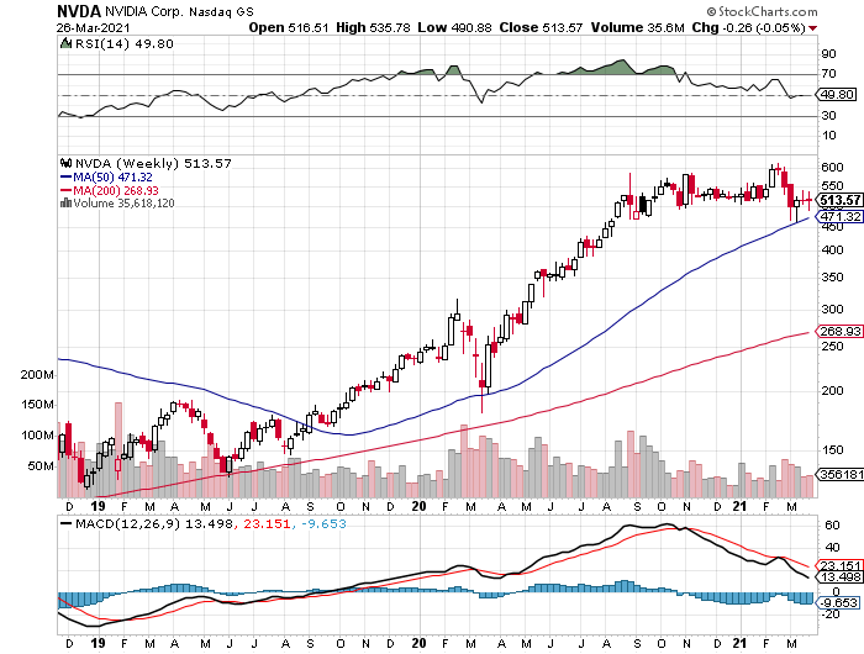
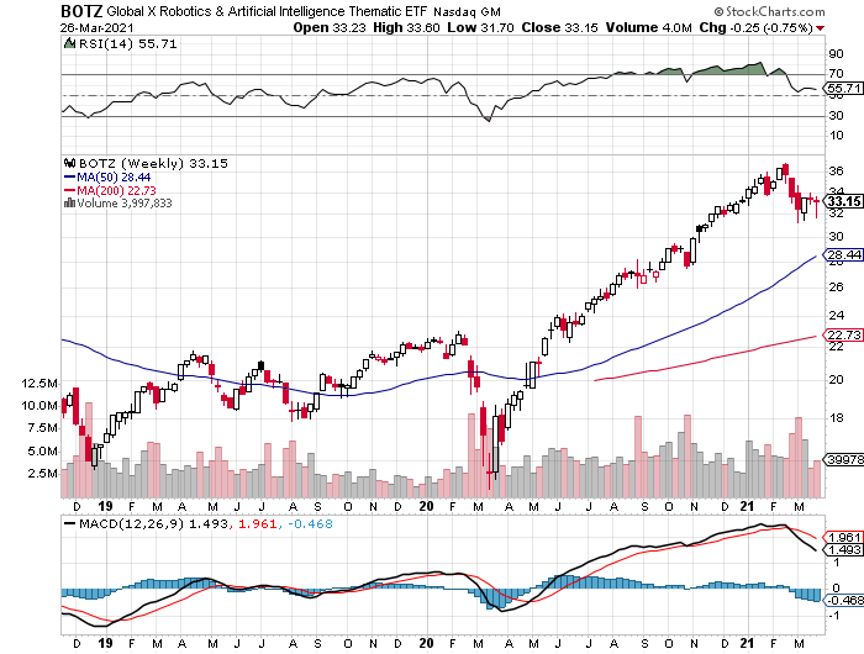


Global Market Comments
June 23, 2020
Fiat Lux
Featured Trade:
(HERE ARE THE FOUR BEST PANDEMIC-INSPIRED TECHNOLOGY TRENDS),
(AMZN), (CHWY), (EBAY), NFLX), (SPOT), (TMUS), (ATVI), (V), (PYPL), (AAPL), (MA), (TDOC), (ISRG), (TMDI)
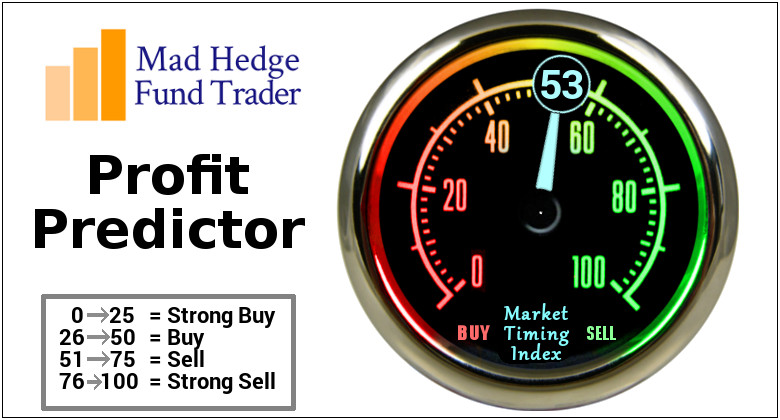
By now, we have all figured out that the pandemic has irrevocably changed the course of technology investment. Some sectors are enjoying incredible windfalls, while others are getting wiped out.
The digitization of the economy has just received a turbocharger. It has become a stock pickers market en extemus.
The good news is that we are still on the ground floor of trends that have a decade to run, like working from home, more online food purchases, and a rise in touchless payments. This means there's a huge upside for investors willing to make big bets on what’s expected to become some of the most important technologies in the years ahead.
Covid-19 is a wake-up call to accelerate trends that have been around for years and are now greatly speeding up. The pandemic seems to have triggered a new survival instinct: innovate fast or die. Let me list some of the frontrunners.
1. E-commerce
E-commerce is the No. 1 shelter-in-place beneficiary by miles, as a combination of stay-at-home orders, reduced spending on dining, and government stimulus have sent Americans in search of other ways to spend their money. Even though Covid-19 restrictions are now being eased, the e-commerce industry should still see about 25% growth across all of 2020.
The estimated $60 billion spent by consumers from their stimulus checks has also been a tailwind. While the world is now re-opening, we expect these buckets of available dollars to remain e-commerce tailwinds for the foreseeable future as we expect adjusted retail and travel spend to decline an aggregate of 18% in and for as much as half of all small retail stores to potentially close this year.
When Amazon shares were at $1,000, I wrote a report calculating that its breakup value was at least $3,000 a share. It looks like Amazon may hit that target before yearend….without the breakup.
Want to know the winners? Try Amazon (AMZN), Chewy (CHWY), and eBay (EBAY).
2. Digital Entertainment
The Covid-19 pandemic has also left more Americans in search of digital, at-home entertainment, a trend that’s delivered a huge push for companies like Activision Blizzard that develop online games. New users, time spend gaming and in-game purchases are only accelerating and spell even more lasting benefit for game developers.
Content names like video streaming site Netflix (NFLX), as well as bandwidth and connectivity companies including Comcast (CMCSA) and T-Mobile (TMUS), are names to focus on.
This increased use of high bandwidth applications is likely to continue post-COVID-19 and has the impact of similarly increasing the demand for bandwidth and connectivity. This increases the value of upstream assets in the infrastructure sectors like fiber-based wireline broadband networks and nascent 5G build-outs.
Names to play the space: Netflix (NFLX), Spotify (SPOT), T-Mobile (TMUS), Activision Blizzard (ATVI).
3. Touchless payments
Another trend the stock market still underappreciated is a generational surge in contactless payments, which has recently seen a jump higher amid Covid-19 fears and efforts to minimize physical contact. Companies like Visa (V), Mastercard (MA), and PayPal (PYPL), already integral to the payments world, should be major beneficiaries in the years ahead.
The market assumes that COVID-19 related adoption of digital payments is a near-term benefit for payment service providers, offsetting some of the consumer spending headwinds. However, digitization of payments is part of a multi-year secular growth driver, with COVID-19 as just the latest accelerator.
Names to play the space: Visa (V), PayPal (PYPL), Apple (AAPL), and Mastercard (MA).
4. Telemedicine
Healthcare is one of the most inefficient industries left in the United States. I call it a 19th century industry operating with 21st century technology. While progress has been made, those massive stacks of paper records are finally disappearing, there still is a long way to go.
These days, even doctors don’t want to see patients in person, as they may contract the Coronavirus. Far better to see them online, which could address 90% of most patients. Teledoc (TDOC) does exactly that (click here for my full report).
So does Intuitive Surgical (ISRG), maker of DaVinci Surgical Systems, which enables remote operations for a whole host of maladies. Titan Medical (TMDI) is another name to look at here.
Names to play the space: (TDOC), (ISRG), (TMDI).
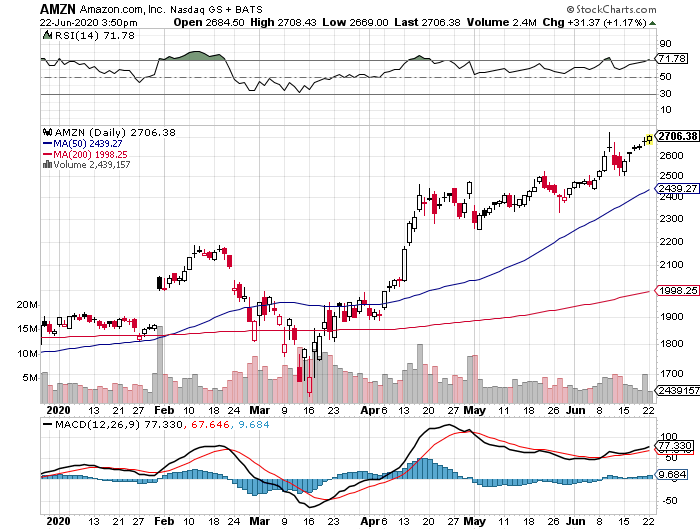
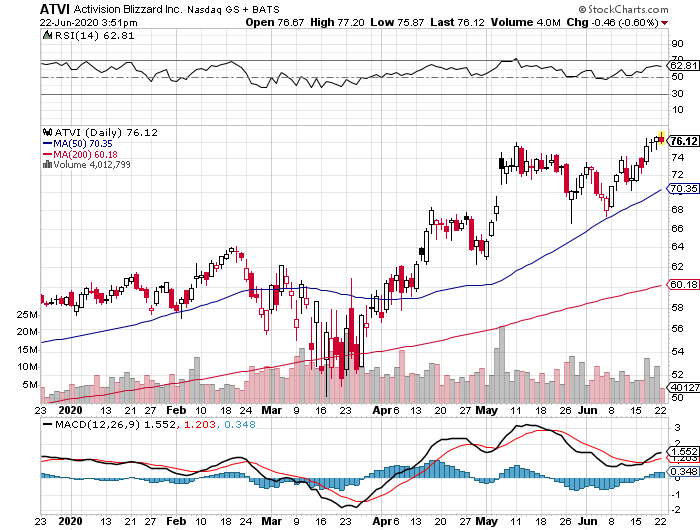
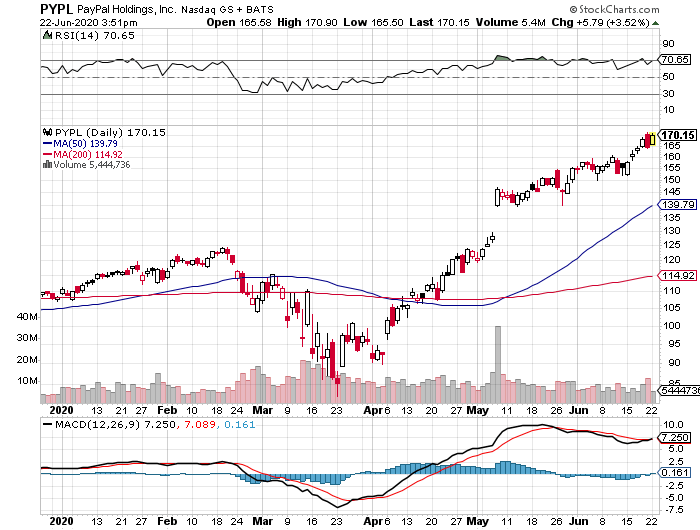
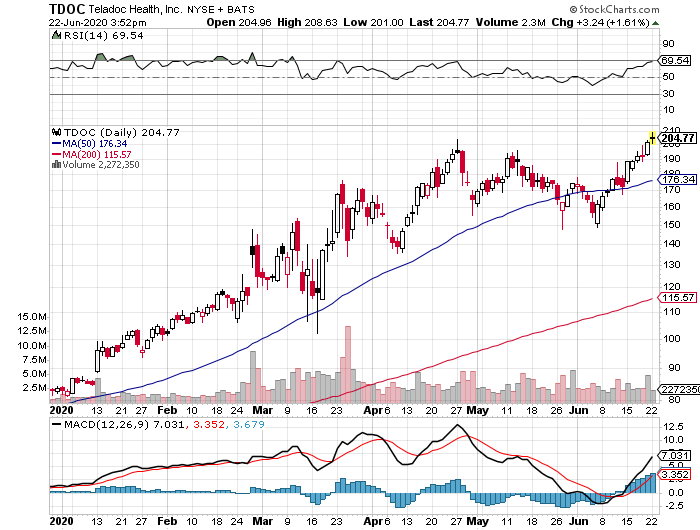

Legal Disclaimer
There is a very high degree of risk involved in trading. Past results are not indicative of future returns. MadHedgeFundTrader.com and all individuals affiliated with this site assume no responsibilities for your trading and investment results. The indicators, strategies, columns, articles and all other features are for educational purposes only and should not be construed as investment advice. Information for futures trading observations are obtained from sources believed to be reliable, but we do not warrant its completeness or accuracy, or warrant any results from the use of the information. Your use of the trading observations is entirely at your own risk and it is your sole responsibility to evaluate the accuracy, completeness and usefulness of the information. You must assess the risk of any trade with your broker and make your own independent decisions regarding any securities mentioned herein. Affiliates of MadHedgeFundTrader.com may have a position or effect transactions in the securities described herein (or options thereon) and/or otherwise employ trading strategies that may be consistent or inconsistent with the provided strategies.
This site uses cookies. By continuing to browse the site, you are agreeing to our use of cookies.
OKLearn moreWe may request cookies to be set on your device. We use cookies to let us know when you visit our websites, how you interact with us, to enrich your user experience, and to customize your relationship with our website.
Click on the different category headings to find out more. You can also change some of your preferences. Note that blocking some types of cookies may impact your experience on our websites and the services we are able to offer.
These cookies are strictly necessary to provide you with services available through our website and to use some of its features.
Because these cookies are strictly necessary to deliver the website, refuseing them will have impact how our site functions. You always can block or delete cookies by changing your browser settings and force blocking all cookies on this website. But this will always prompt you to accept/refuse cookies when revisiting our site.
We fully respect if you want to refuse cookies but to avoid asking you again and again kindly allow us to store a cookie for that. You are free to opt out any time or opt in for other cookies to get a better experience. If you refuse cookies we will remove all set cookies in our domain.
We provide you with a list of stored cookies on your computer in our domain so you can check what we stored. Due to security reasons we are not able to show or modify cookies from other domains. You can check these in your browser security settings.
These cookies collect information that is used either in aggregate form to help us understand how our website is being used or how effective our marketing campaigns are, or to help us customize our website and application for you in order to enhance your experience.
If you do not want that we track your visist to our site you can disable tracking in your browser here:
We also use different external services like Google Webfonts, Google Maps, and external Video providers. Since these providers may collect personal data like your IP address we allow you to block them here. Please be aware that this might heavily reduce the functionality and appearance of our site. Changes will take effect once you reload the page.
Google Webfont Settings:
Google Map Settings:
Vimeo and Youtube video embeds:
